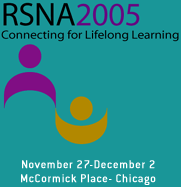
Abstract Archives of the RSNA, 2005
Martin Joel Yaffe PhD, Presenter: Nothing to Disclose
Roberta Agnes Jong MD, Abstract Co-Author: Nothing to Disclose
Judith A. Wolfman MD, Abstract Co-Author: Nothing to Disclose
Robert Edward Hendrick PhD, Abstract Co-Author: Nothing to Disclose
Petrina Ann Causer MD, Abstract Co-Author: Nothing to Disclose
Eric A. Berns PhD, Abstract Co-Author: Nothing to Disclose
Anat Kornecki MD, Abstract Co-Author: Nothing to Disclose
Lora Duyan Barke DO, Abstract Co-Author: Nothing to Disclose
Mariam Thomas MD, Abstract Co-Author: Nothing to Disclose
Lewis I. Segal MD, Abstract Co-Author: Nothing to Disclose
Shalini S. Umranikar MD, Abstract Co-Author: Nothing to Disclose
Belinda Curpen, Abstract Co-Author: Nothing to Disclose
Ashwini Kshirsagar, Abstract Co-Author: Nothing to Disclose
Arshia Ali, Abstract Co-Author: Nothing to Disclose
Sam Shen, Abstract Co-Author: Nothing to Disclose
et al, Abstract Co-Author: Nothing to Disclose
To evaluate the potential impact on accuracy and radiologist’s workload of using CAD as a pre-screening tool in breast cancer screening.
Digital mammograms from 220 women were retrospectively analyzed using a computer-aided detection algorithm optimized for digital mammography (R2 Image Checker, Version 8). The images were independently interpreted by five radiologists experienced in mammography and five trainees. The image set included 150 examinations of women without breast cancer and 71 biopsy-proven cancers in 70 women (one bilateral). The number, type and “importance” of CAD marks were scored using an objective technique and scores from the two views of each breast were added. Hypothetical thresholds were applied to the scores to determine whether the images would be referred to the radiologist for interpretation or considered “normal”.
For this case set, the mean sensitivity and specificity of the radiologists were 65% (range 49-87%) and 85% (range 75%-96%) respectively. If the threshold of the screen were set such that any examination with one or more CAD marks was referred to the radiologist, only 1 in 71 cancers would not have been referred (sensitivity of the prescreen = 98.6%). This cancer was missed by all 10 radiologists. At this threshold, 21 cases would not have been referred, resulting in a workload reduction of 14% with no loss in sensitivity. If the mammographic views without CAD marks were not interpreted (although still displayed for evaluation of symmetry), the number of images to be interpreted would be reduced by 39%. If the threshold was raised to require more than one CAD mark for referral, the sensitivity of the pre-screen would fall to 91.6% and the workload would be reduced by 48% on a per case basis and by 67% on a per breast basis.
Use of CAD as a pre-screening tool could provide increased efficiency at interpretation of screening mammograms, allowing radiologists to be more productive while concentrating their viewing time more effectively on images in which cancer was present.
A.K.: Ashwini Kshirsagar is an employee of R2 Technologies.M.J.Y.: Martin Yaffe's laboratory has a research collaboration on topics in digital mammography with GE Healthcare
Yaffe, M,
Jong, R,
Wolfman, J,
Hendrick, R,
Causer, P,
Berns, E,
Kornecki, A,
Barke, L,
Thomas, M,
Segal, L,
Umranikar, S,
Curpen, B,
Kshirsagar, A,
Ali, A,
Shen, S,
et al, ,
Performance of CAD for Pre-screening with Digital Mammography. Radiological Society of North America 2005 Scientific Assembly and Annual Meeting, November 27 - December 2, 2005 ,Chicago IL.
http://archive.rsna.org/2005/4408601.html

